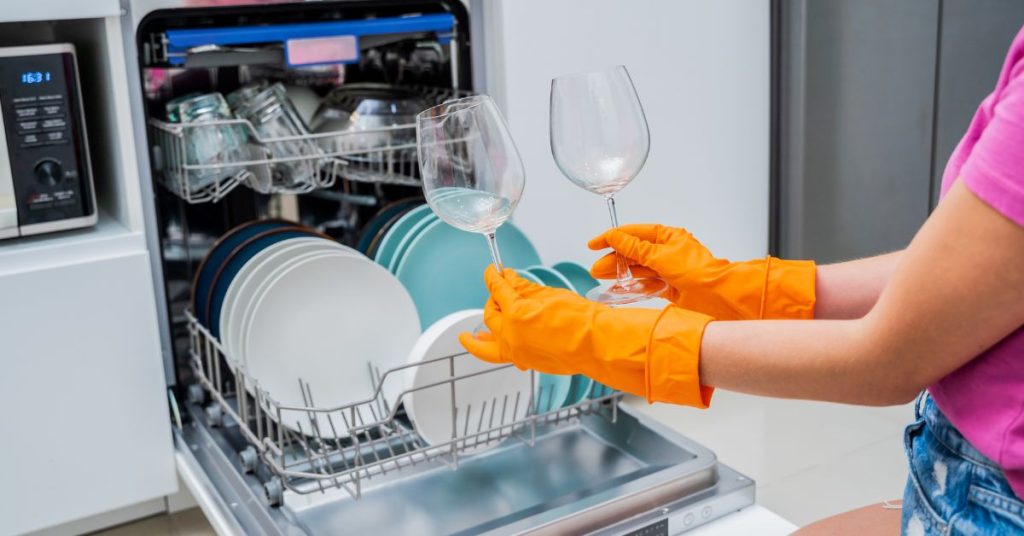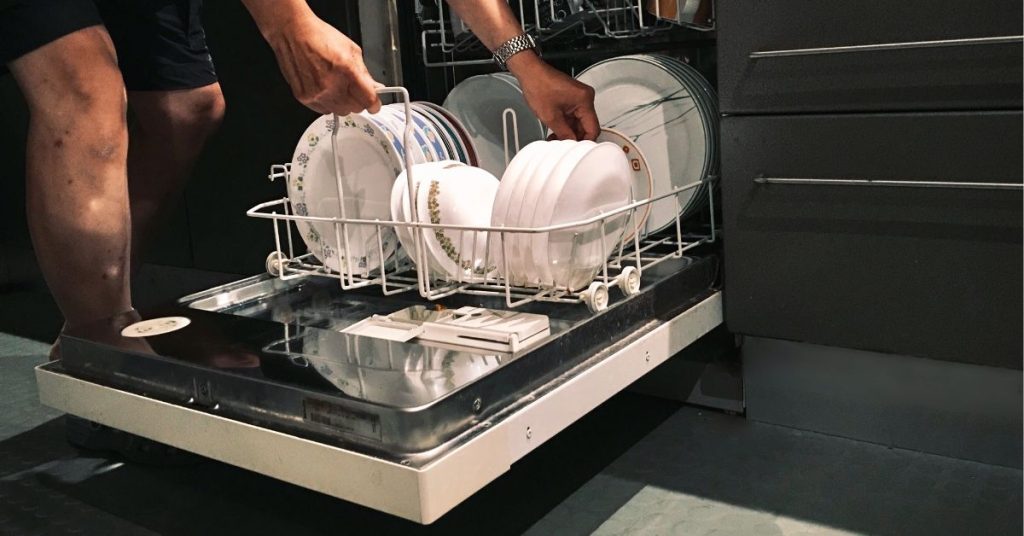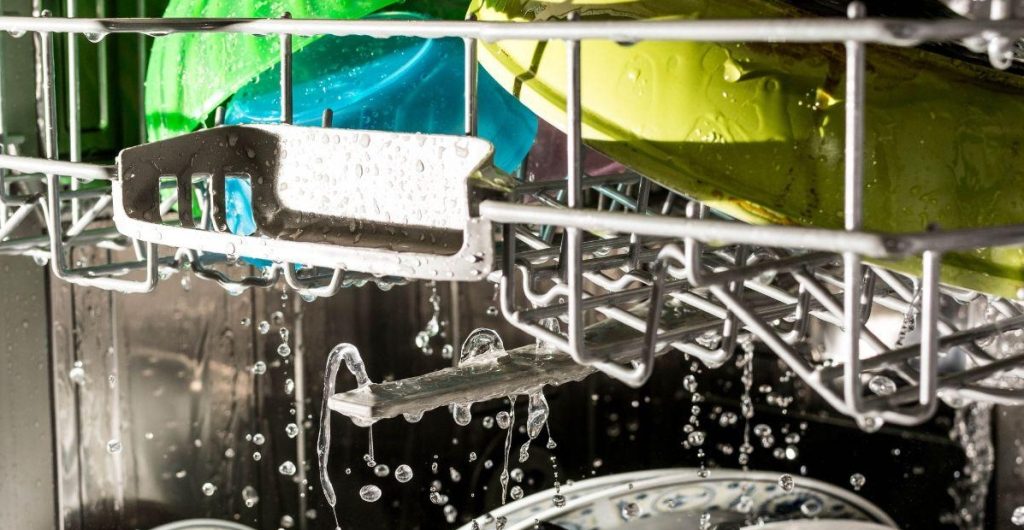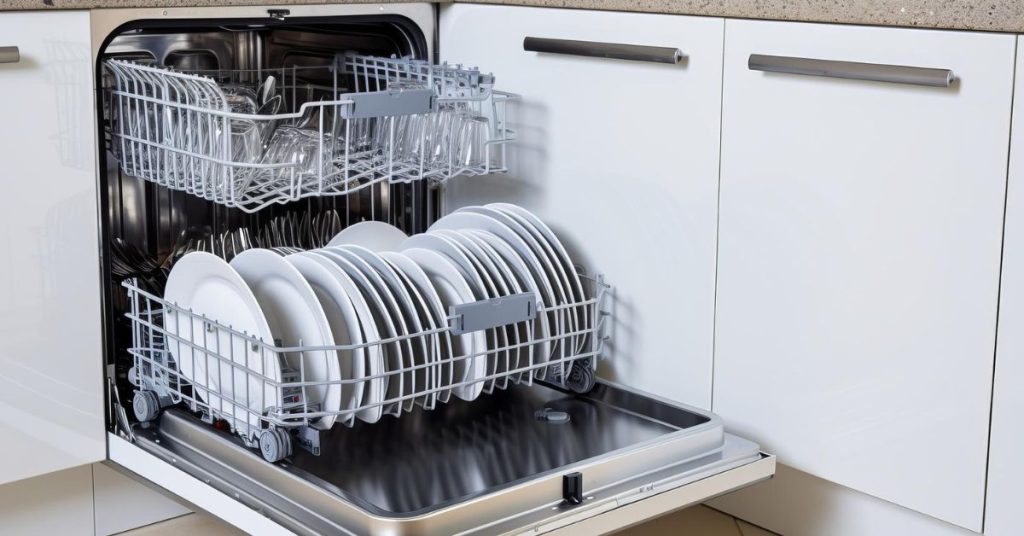When it comes to cleaning dishes in a small kitchen or an apartment with limited space, a portable dishwasher is an excellent solution. Choosing the right model can make a big difference in convenience and efficiency. In this guide, we will explore the types of portable dishwashers, their size and capacity, noise levels, drying methods, and other considerations to help you make the best decision.
Portable Dishwasher Type: Countertop Versus Freestanding
Portable dishwashers generally come in two types: countertop and freestanding models.
- Countertop dishwashers are compact and designed to sit on a counter, ideal for smaller kitchens or apartments where space is limited. They usually hold fewer dishes than freestanding models but are much more space-efficient.
- Freestanding dishwashers are larger, often on wheels, and can be moved as needed. They hold more dishes and are suitable for people who need more cleaning capacity but still want a portable option.
There are two types of portable dishwashers: countertop and freestanding. Freestanding portable dishwashers look like standard dishwashers with interiors often comparable in capacity. Countertop dishwashers, sometimes called mini dishwashers, are much smaller – about the size of a microwave. They’re compact enough to sit on a kitchen counter but offer less capacity. Some compact dishwashers can’t accomodate large dishes including larger plates, bowls and cutting boards.
Size and Capacity Differences
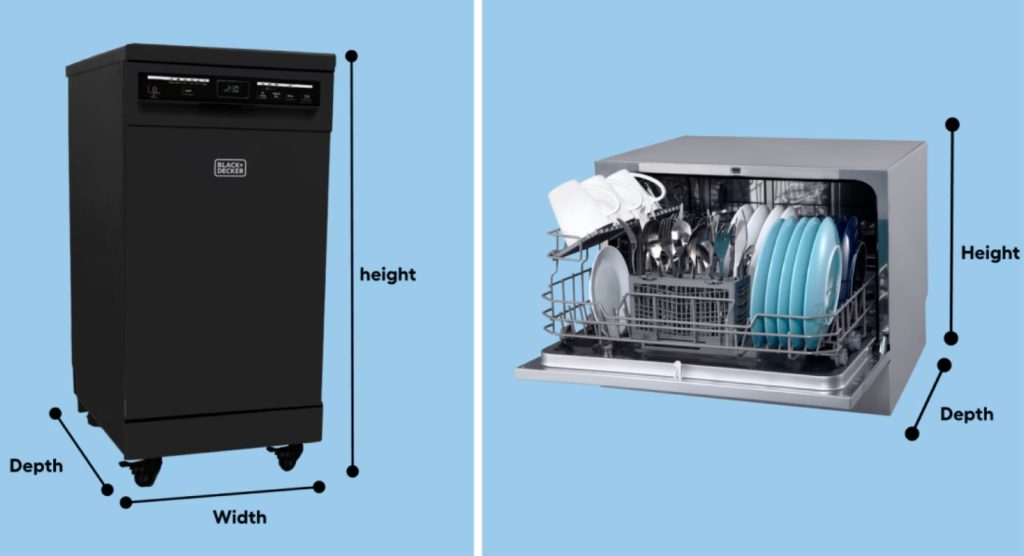
The size and capacity of a portable dishwasher play a crucial role in choosing the right model for your needs.
- Countertop dishwashers typically hold around 4-6 place settings, making them ideal for singles, couples, or small families. They are great if you’re short on space but still want the convenience of a dishwasher.
- Freestanding dishwashers usually offer more capacity, with larger models accommodating 8-12 place settings. These models are better for larger families or people who entertain frequently.
Unlike the standard dishwasher size, portable options range from extra compact to comparable to a traditional built-in dishwasher. The bulk of portable dishwashers are 18 or 24 inches wide, although countertop options are typically smaller. In addition to standard measurements, like height, width and depth, you should also consider a portable dishwasher’s capacity. Some portable dishwashers can accommodate up to eight place settings while others offer less capacity.

Color Options
While it might seem like a trivial feature, color options can play a role in how well your portable dishwasher fits with your kitchen decor. Many models come in standard white, black, or stainless steel finishes, which are generally easy to match with existing appliances.At Pyvor, portable dishwashers are available in standard appliance colors: stainless steel, black and white. This makes it possible to match your portable dishwasher to existing appliances in the kitchen.
Noise Levels
Noise is an important consideration, especially if your kitchen or living space is open. While some dishwashers are quieter than others, they can still be noisy compared to built-in models.
- Countertop dishwashers tend to be quieter due to their smaller size, while freestanding dishwashers may be noisier due to their larger motors and capacity.
Some homeowners want their dishwasher to make as little sound as possible. When shopping for any new dishwasher, portable or other, check the appliance’s decibel rating (dBA). The lower the rating, the quieter the dishwasher will be during operation. Because portable dishwashers are typically standalone appliances, instead of built-in to surrounding cabinetry, the sound they produce isn’t dampened by cabinets and walls. Today, most dishwashers have a dBA between 38 and 62. To be considered quiet, a dishwasher’s dBA should fall at or under 52 dBA.
Drying Method
The drying method used by portable dishwashers can affect both the quality of drying and energy efficiency. Common drying methods include:
- Heated drying: Utilizes a heating element to dry the dishes after washing. This method is effective but can use more energy.
- Air drying: Uses natural air to dry the dishes, which is more energy-efficient but can take longer.
Portable dishwashers are available with a few types of drying methods: air dry, heated dry and condensation dry. Heated dry is the most efficient option, but it requires more energy and it’s not suitable for more gentle dish materials. Condensation dry is the more energy-efficient option, but it may not dry all moisture while taking more time. The most energy-conscious drying method is air dry. However, this option can take several hours and may leave moisture behind. Take drying method into consideration when choosing a portable dishwasher.
Portable Dishwasher Considerations
When selecting a portable dishwasher, keep in mind the following factors:
- Water connection: Most portable dishwashers connect directly to your kitchen faucet. Make sure your faucet is compatible with the dishwasher’s hose.
- Energy efficiency: Look for models that are energy-efficient to save on electricity and water bills.
- Ease of mobility: Check if the model has wheels or a handle to make moving it around easier.
The biggest considerations with this type of dishwasher are the settings. Most portables have many of the same features as built-ins.
Another consideration is size. Even if you can move it, you still need to consider size. This way you know if you have room to store it when it isn’t in use. Most portable dishwashers range from 18 inches (46 centimeters) wide, 36 in (91 cm) tall and 26 in (66 cm) deep to around 24 in (61 cm) wide, 37 in (94 cm) tall and 30 in (76 cm) deep.
You should also consider sound. Remember, this is a full-size dishwasher without the noise dampening of cabinets and walls around it. Look for units that boast quiet operation as a feature.
When shopping, some sites will list the unit’s noise level. The lower the decibel rating, the better. Typical dishwashers have a noise level of 63 to 66 dBA. Quieter portable units have a decibel rating of around 55 dBA, which is about as loud as a microwave.
Countertop Considerations
Countertop dishwashers are smaller and more portable, but they do have some unique considerations:
- Placement: Make sure you have enough space on your countertop to accommodate the model. They need to be placed near a faucet and drain.
- Water drainage: Countertop dishwashers typically use a small drain hose, which can either drain into the sink or a small container. Ensure that your sink or drainage area can handle this.
Countertop dishwashers come with many different features. The biggest considerations is size.
If you’re planning on moving it from one counter to another, choose a light one. These washers can range from around 10 to 50 pounds (around 4.5 to 22.6 kilograms).
Even if you’re not planning on moving it, you also need to think about how much space it will take up on your counter. Most units are around 22 in (56 cm) wide, 17 in (43 cm) tall and 20 in (51 cm) deep, though there are bigger units. Be sure to measure your countertop before shopping.
Size typically corresponds to how many place settings you can wash at once. Units range from a four place setting to six place setting capacity.Another consideration is noise. You can find countertop dishwashers with a noise level of 55.
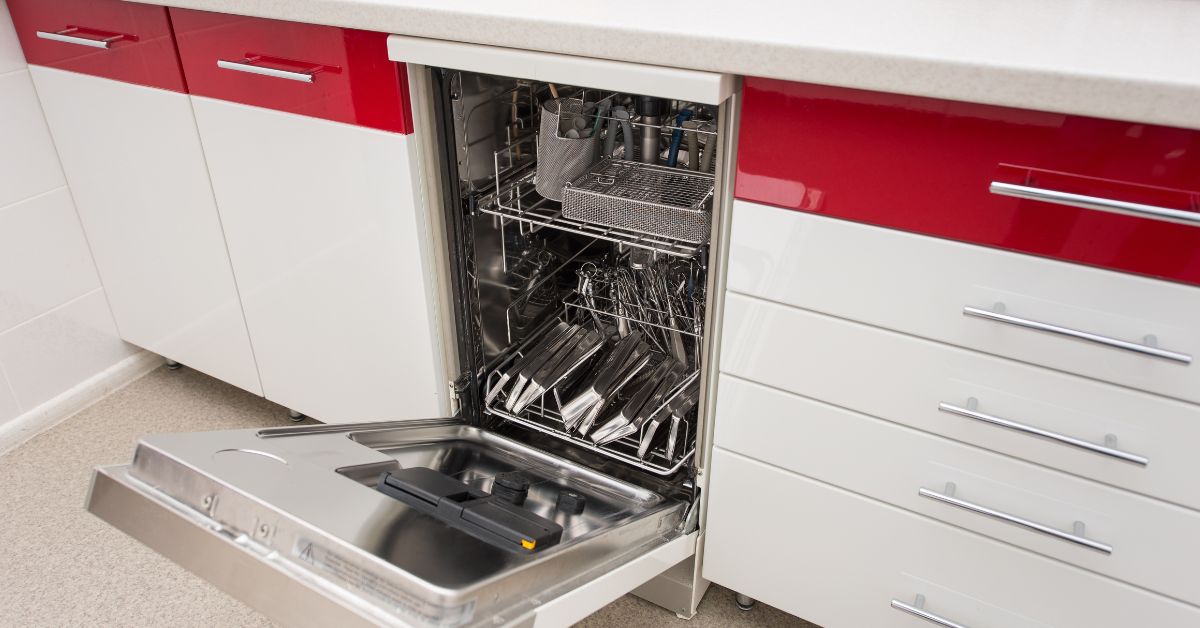
Control Panel Style (Hidden Top vs. Visible Front)
The control panel allows you to make cycle selections, including the duration of the dishwashing cycle, water temperature, and more. The control panel of a portable dishwasher is designed to be on the top or front of the unit.
Portable dishwashers with front control panels are completely visible, while those with top control panels are hidden.

Dishwasher Cycles
Portable dishwashers have a variety of wash cycle types. Some standard options include:
- Delayed Wash
- Gentle Wash
- High-Temperature Wash
- Quick Wash
- Sensor Wash
Adjustable Top Rack
Some portable dishwashers have an adjustable top rack, handy when washing oversized dishes, cutting boards, and other large items. The adjustable top shelf can be moved up or down to make more room in the dishwasher’s top or bottom rack.
What You Should Know Before You Buy a Portable Dishwasher
Before diving in and buying one, portable dishwashers have a few considerations.Some faucets are not compatible with portable dishwashers. Because the dishwasher’s intake hose only attaches to a threaded faucet spout, sure, faucets with built-in sprayers are not compatible with most portable dishwasher hookups.
Rolling portable dishwashers are incredibly heavy. Mine weighs over 100 pounds, a fact I only discovered once I had it in my possession and was faced with the daunting task of getting it up the stairs and into my house by myself. I plan to have help with moving equipment.Your lease may prohibit portable dishwashers. If you’re a renter, check your lease to make sure you’re allowed to have one.
FAQs
Where should a portable dishwasher be placed in the kitchen?
It’s best to place a portable dishwasher near the kitchen sink. So that you can get easy access to water and drainage. Make sure it’s on a stable, flat surface with enough space for ventilation. When using a dishwasher with wheels, lock them to prevent movement. Besides, ensure that you can easily connect and disconnect the hose from the faucet and access the controls.
Are portable dishwashers as effective as built-in models?
Yes, a portable dishwasher can provide the same level of cleaning performance as a built-in one. It mainly depends on the features of the dishwasher. You should choose one that meets your household’s needs.
Can I use a portable dishwasher if I have a small kitchen?
Yes, portable dishwashers are ideal for small kitchens or apartments where space is limited. They are versatile and can be stored when not in use. Besides, you can move them when necessary.
How do I connect a portable dishwasher to my kitchen faucet?
Most portable dishwashers come with adapters. It allows them to connect to standard kitchen faucets.
Do portable dishwashers use a lot of water?
Portable dishwashers are generally more water-efficient than handwashing. Make sure the model you choose has energy-saving features and water-saving cycles.
Are portable dishwashers noisy?
The latest portable dishwashers operate silently, similar to built-in models. If noise is a concern in your living area, check the product specifications.
What size portable dishwasher should I choose?
It mainly depends on the space of your kitchen. Besides, take into account your household size and dishwashing habits.
Are portable dishwashers easy to move?
Yes, portable dishwashers are designed for easy mobility. You can move them around your kitchen using wheels or casters.
Can I use regular dish soap in a portable dishwasher?
You should not use regular dish soap in a portable dishwasher. You should use dishwasher detergent specially designed for automatic dishwashers to prevent excessive sudsing and damage to the machine.
Do portable dishwashers require any exceptional plumbing?
No, portable dishwashers do not require exceptional plumbing. The faucets of portable dishwashers are designed to connect to standard kitchen faucets, which makes them easy to install.
Are portable dishwashers energy-efficient?
There are a number of portable dishwashers that come with energy-saving features. They offer eco-friendly wash cycles and energy-efficient motors. If you’re looking for energy-efficient models, make sure they’re Energy Star-rated.
The Takeaway
Choosing a suitable portable dishwasher can improve your kitchen’s efficiency and convenience. You have to consider factors like size, capacity, performance, and ease of use to find a suitable model. You have to check the features before selecting one. With a suitable portable dishwasher, you can get sparkling clean dishes with little effort.

